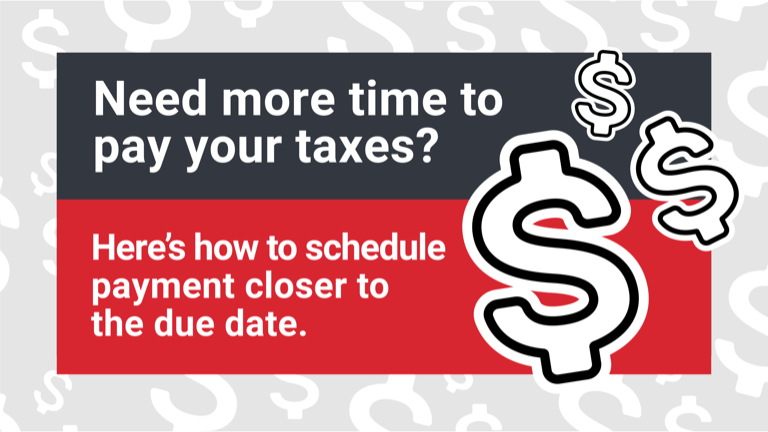While many Americans get a tax refund from the IRS each year, some taxpayers owe. Sometimes the bill can be too large for some individuals to pay at once, so the IRS has several more flexible options.

What if I can’t pay when I file?
First, it’s important to understand that you are still required to file your tax return on time even if you can’t pay the taxes you owe on time. Filing on time will prevent you from being charged late filing penalties.
If you can’t pay your taxes on the same day you file, TaxSlayer lets you schedule your payment closer to the due date. Here’s how:
- After you have completed your return, choose the bank account/direct deposit option for your payment method.
- Enter your bank account information. The IRS will withdraw your payment from this account.
- Next, enter the amount you plan to pay and the date you want the funds transferred.
- Repeat this step for your state tax return if you owe state income tax.
TaxSlayer makes it very simple to do in the e-file process, but you can also schedule a payment date directly through your bank – like some people do with regular bills. Just make sure you schedule the payment before Tax Day!
What if I don’t pay my taxes?
If you fail to pay your tax bill by Tax Day, you will begin to incur penalties and fees beginning the day after you fail to pay.
Some of the more serious consequences include:
- A federal tax lien can be filed against your property.
- Your salary/accounts can be seized through a tax levy.
- You can be served a summons asking you to provide more information.
Read more about what happens if you don’t pay your taxes here.
How do I pay when I file?
Your payment options depend on if you file online or through the mail. If you file online with TaxSlayer, you can pay in a couple of ways.
- Electronic withdrawal: Provide your bank’s routing number and your account number to have the amount withdrawn on a date of your choice any time before the federal filing deadline.
- Mailed payment: You can pay your tax bill by check, cashier’s check or money order, even if you file your return online. However, the IRS encourages taxpayers to consider using an electronic payment method if possible.
- Credit card: If you would rather pay with your credit card, there are several third-party payment companies that can process your payment. Learn more about paying your taxes with a credit card here.
You can pay your state and federal taxes owed at the end of your e-file process with TaxSlayer. Alternatively, the IRS and some states allow you to pay directly on their website using debit, credit, or electronic funds transfer.
What are my payment plan options?
If you can’t pay in full by Tax Day, the IRS offers several payment plans.
Short-term payment plan:
If you can pay your bill in full in less than 120 days, apply for this plan to pay monthly automatic payments.
Long-term payment plan (installment agreement) option 1:
If you need more than 120 days to pay, use this plan to pay through direct debit (automatic monthly payments from your checking account).
Long-term payment plan (installment agreement) option 2:
This plan is very similar to the plan above, but includes multiple payment options, including:
- Monthly payment directly from a checking or savings account (Direct Pay)
- Monthly payment electronically online or by phone using Electronic Federal Tax Payment System (EFTPS)
- Monthly payment by check, money order, or debit/credit card (Fees apply when paying by card)
Learn more about applying for installment agreements with TaxSlayer and how they work.
Changing an existing payment plan:
If your current plan is not working for you or you owe more money, you can revise it online, by phone, mail, or in person.
Reinstating a payment plan:
If you previously had a payment plan and need to reinstate it for the current tax year, you can apply to use your same plan again.
Offer in compromise:
If you meet strict IRS requirements, you might be able to settle your tax bill for less than the full amount you owe.
First-time penalty abatement:
If you meet certain guidelines, you might be able to waive failure-to-file and failure-to-pay penalties.
Always be sure to file on time with TaxSlayer – even if you can’t pay when you file.




